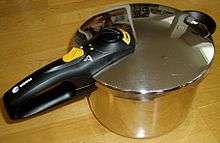Cookbook:Pressure Cooking
Cookbook | Recipes | Ingredients | Cooking techniques

Pressure cooking is a method of cooking in which the boiling temperature of water is increased using a special vessel, causing the food to cook faster. Cooking times can be reduced by a factor of three or four. For example, shredded cabbage is cooked in one minute, fresh green beans take about five, small to medium-sized potatoes (up to 200 g) may be ready in five minutes or so and a whole chicken takes no more than twenty-five minutes. It is often used to simulate the effects of long braising or simmering in shorter periods of time.
This is accomplished using a pressure cooker, a sealed vessel that does not permit steam to escape until a preset pressure is achieved. Because water's boiling point increases as the pressure increases, the pressure built up inside the cooker allows the liquid in the pot to rise to a temperature higher than 100 °C (212 °F) before boiling. A safety valve releases steam when the pressure exceeds the safety limit for the cooker; usually the steam pressure lifts a weighted stopper allowing excess pressure to escape. There is usually a backup pressure release mechanism, in the form of a hole in the lid blocked by a plug of low melting-point alloy, a rubber seal and pin, or a rubber ring seal. If internal temperature (and hence pressure) gets too high, the release mechanism will trigger, resulting in a release of the pressure. However, it is best not to rely on this feature.
A pressure cooker can be used at high altitude to compensate for lower atmospheric pressure. Without it, water boils off before reaching 100 °C, lengthening the cooking time for recipes.
In some countries, the microwave has replaced the pressure cooker as a technical fix for faster cooking, but cannot perform the same task that programmable electronic pressure cookers, as delayed cooking and other features.